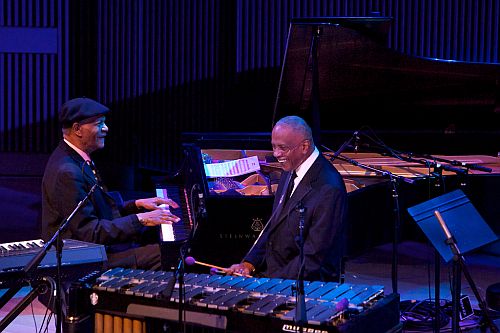 United States SFJAZZ Collective: plus Mary Stallings (voice), Regina Carter (violin), Joshua Redman (alto sax), Eric Harland (drums), Bobby Hutcherson (vibraphone), McCoy Tyner (piano), SFJAZZ Center, San Francisco. 26.1.2013 (HS)
United States SFJAZZ Collective: plus Mary Stallings (voice), Regina Carter (violin), Joshua Redman (alto sax), Eric Harland (drums), Bobby Hutcherson (vibraphone), McCoy Tyner (piano), SFJAZZ Center, San Francisco. 26.1.2013 (HS)

SFJAZZ opened its long-awaited jazz-specific performance venue, the SFJAZZ Center, this week in San Francisco, in the same Civic Center neighborhood as Davies Symphony Hall, War Memorial Opera House and Herbst Hall. SFJAZZ has been presenting concerts, including the San Francisco Jazz Festival, since 1983 in various locations (including those). It’s about time the form often called America’s classical music had a permanent home here—price tag $64 million, free of the clinking glasses common to lounges and bars.
Heard Saturday night, the fourth in a series of opening-week all-star concerts featured the SFJAZZ Collective, an eight-piece jazz ensemble that has been producing its own music since 2004. The evening also offered an opportunity to hear ensembles of various sizes in the new Miner Hall, which depending on configuration can seat 350 to 700. Aside from several pieces for the full octet, guest artists with connections to San Francisco performed in small combinations, including a duet for piano and drums, a piece for vocalist Mary Stallings and a rhythm section, and a stunning pairing of the pianist McCoy Tyner with the vibraphonist Bobby Hutcherson, both titans of their generation.
Amplification (pretty much standard in jazz) was clear and resonant, deftly balanced and unobtrusive. The sharp rake of the audience seating, and the way it surrounds the musicians even as most of the seats face them, produces an intimate feeling. It would be interesting to hear classical chamber music in this environment. I wonder if the Kronos Quartet are licking their chops at the possibility.
Amplification may separate the form from most classical performances, but there are more overlaps, including the virtuosity required to play the music, the complexity possible, and in this concert at least, a level of musicianship, intonation and articulation that equaled the best practitioners in any form.
The pieces heard went well beyond the simple song templates expanded by improvised choruses that characterized jazz for much of its history. The opening “Mastermind,” an original work by the group’s alto saxophonist Miguel Zenón, began with a quietly articulated complex drum rhythm. A series of chords, riffs and slides by the horns (alto and tenor sax, trumpet, trombone) provide a counterpoint, before the piece explores various instrumental voicings, much of it contrapuntal. Sonic combinations of the various winds with vibes, bass and piano created endless colors.
“Mastermind,” however, never quite got revved up. Other pieces showed similar breadth while upping the energy and swing, especially arrangements of Thelonious Monk’s “San Francisco Holiday” and Bobby Hutcherson’s “March Madness.” In his arrangement of Chick Corea’s already complex “Spain” the group’s pianist, Edward Simon, introduced variations in tempo, style, harmonic colors and rhythm. Corea opened his original version with the theme from the slow movement of Rodrigo’s Concierto de Aranjuez, but Simon saved that reference for a brief appearance by the trumpet in the coda, all but quoting Gil Evans’ famous arrangement of the tune for Miles Davis.
Trumpeter Avishai Cohen played that with understatement—a series of nicely judged solo moments in the Collective’s work. Of special note was Stefon Harris’s extraordinarily expressive playing on vibraphone, contrasting rhythmic clout against glassy legatos that tied notes together in a way mallet instruments should not be able to do so smoothly. Also, Robin Eubanks contributed taut and expressive articulation to his trombone solos and David Sánchez explored a full range of possibilities on tenor sax.
Stevie Wonder’s “Higher Grounds” featured guest violinist Regina Carter playing the theme in high harmonics with pinpoint accuracy and creating a story-telling solo improvisation. Another wide-ranging arrangement of a Wonder tune, “Superstition,” closed the concert with verve.
Longtime jazz veterans provided some of the most memorable moments. Mary Stallings, 73, an under-appreciated vocalist who can call to mind Dinah Washington or Carmen MacRae, delivered a soulful version of “I Thought About You,” by Jimmy Van Heusen and Johnny Mercer. It was a lesson in words leading the music.
The showstopper, however, was a duet by Hutcherson and Tyner, both in their 70s. Hutcherson, looking frail from an ongoing respiratory condition, had to be led onto the stage to the vibes. Tyner looked only slightly more spry as he made his way to the piano. The music, Tyner’s “Pererina,” took a couple of minutes to find its footing, but once the rhythm locked into place it became muscular, and took off like a rocket. The mind meld between these two musicians, who have played together off and on since 1966, was uncanny to hear, and their musical inventiveness never flagged. An unscheduled ballad, “Title,” if anything was even more beautiful, and served as a sort of mid-concert encore.
In another highlight the group’s founding artistic director, alto saxophonist Joshua Redman, a mere 43, created an arresting trio with Eric Harland, the group’s drummer until last year, and Matt Penman, the current bassist. The communication among the trio, especially the way Harland wove his detailed playing into the others’ improvisations, could only happen if the three play together regularly and they do, in a quartet called James Farm. Penman’s extended solo, played against only a delicate drum accompaniment, ranged all over the bass’s fingerboard, losing none of the pulse or the harmonic changes.
Even without piano this trio parlayed a free-jazz opening into a harmonically complete, endlessly fascinating, smoothly swinging exploration of “Mack the Knife.” Written by Kurt Weill for his Threepenny Opera, the piece probably was not programmed as a sly nod to the classical opera company up the street. But as sheer excitement and top-tier musicianship, it belonged in the same league.
Harvey Steiman